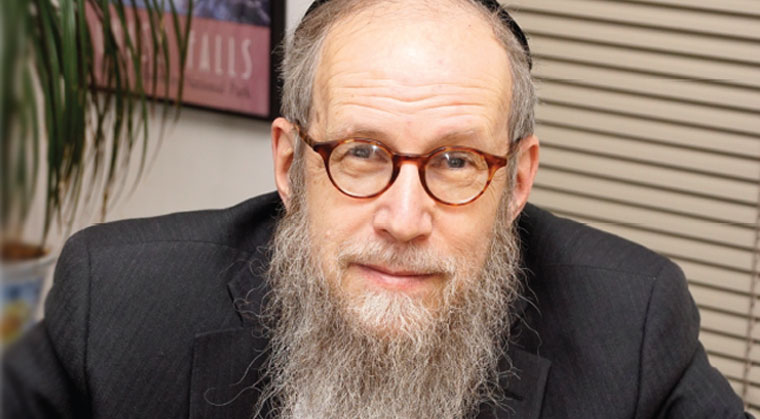Beyond Nails in the Grocery Store

Son of a pioneer of Colorado’s media world, Hillel Goldberg was expected to continue his family’s newspaper. But a mussar scholar, writer, and seforim author, too?

Photos: Avital Rotbart
W hile planning a recent West Coast trip I had contacted Rabbi Hillel Goldberg to ask about interesting people to interview in Los Angeles. I knew Reb Hillel to be well-traveled and a resident of Denver Colorado which to a New Yorker seems like just around the corner from L.A. I wasn’t quite prepared for his response: “I don’t know what topics you’re looking to cover but there’s a guy named Josh who’s the car-service driver I used the last time I was in L.A. and I got a very fine dose of yiras Shamayim listening to him. The number I have for him is…”
It was vintage Goldberg. An intimate of great rabbinic personalities he’s an acclaimed author and award-winning journalist respected in yeshivah and academic circles alike. Yet he takes inspiration where he finds it even in the back seat of a cab — and the vignettes of Jews famous and unknown that fill the pages of his most recent book The Unexpected Road: Storied Jewish Lives Around the World attest to that as well.
Now I’ve come to the Mile High City for an elevating conversation of my own with Reb Hillel and entering his office at the Intermountain Jewish News where he’s the executive editor and writes the longest-running column in Jewish journalism the first thing I glimpse on his desk is a volume entitled Mind Over Man. It’s a newly published collection of vaadim given by Rav Yechiel Perr a rosh yeshivah and leading contemporary exponent of mussar thought.
The warm inscription inside the book reflects Rabbi Perr’s appreciation for Reb Hillel as a longtime student of mussar and the Eastern European–born movement that championed it. His groundbreaking books The Fire Within and Illuminating the Generations helped make the personalities and concepts of the mussar movement accessible to the Jewish reading public. A writer friend recently shared with me that when The Fire Within first appeared he read it and then reread it numerous times in what was a life-changing experience for him.
Keeping It in the Family
That Hillel Goldberg succeeded in forging a link to the storied mussar masters of prewar Europe is all the more striking given his own upbringing in a radically different time and place: 1950s and 1960s Denver. His father Max was the eighth of nine children born to poor immigrants on the city’s West Side. When their father passed away during the worldwide flu epidemic of 1918 it was left to seven-year-old Max and his five older brothers to support the family by becoming newsboys for the Denver Post.
From selling papers on Denver’s street corners Max Goldberg would go on to become one of the major figures on Colorado’s mid-20th century media and political scenes. A newspaper reporter by age 19 and later a radio sports show host for 25 years he also wrote a popular column in the Post that mixed business politics and humor.
Reb Hillel says his dad was someone who “was always doing more than one thing at a time,” a man of action who in the 1940s raised more money in Denver for war bonds than had been raised in all of Chicago. And so, alongside his media endeavors, he opened a public relations firm that handled some of the leading names in state and local politics. That, in turn, enabled him to pioneer in bringing network television to Colorado, securing the FCC license and putting together the business group that bought Channel Nine to Denver.
The capstone of his long media career was serving as host of On the Spot, a highly rated TV show of a genre, Reb Hillel observes, that no longer exists — “a one-on-one interview show on a highly literate level. He was able to get the great personalities of the age to come on his show without fee — people like Martin Luther King, John F. Kennedy, Arthur Goldberg, Nelson Rockefeller, George Wallace, Jimmy Hoffa, and the list goes on.”
Max belonged to a “traditional,” albeit mixed-seating, synagogue, and maintained a close relationship with its rabbi, Charles (Eliezer Hillel) Kauvar. Although he was ordained by the Jewish Theological Seminary, which is today the Conservative movement’s flagship school, Rabbi Kauvar was in the last graduating class, in 1902, when it was still an Orthodox institution. Rabbi Goldberg says the rabbi “did a lot of mitzvos under the radar, such as helping support a number of impoverished old-time European rabbanim on Denver’s West Side, even raising the money to publish their seforim.”
Max’s long career in media gained a Jewish angle when, in 1943, he and a partner paid one dollar to take over the Denver Jewish community paper, the Intermountain Jewish News (IJN), which had been bleeding money ever since its founding three decades earlier by the local Federation. But in October 1972, just days after his 61st birthday, Max Goldberg died, and the reins of the publication passed to his wife Miriam.
Oops! We could not locate your form.













